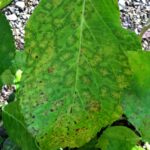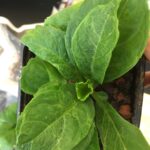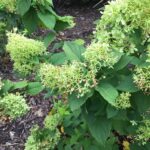Hydrangea L. (family Hydrangeaceae Dumort) is an all-encompassing description of a group of herbaceous and woody flowering plants, composed of more than 80 species native to Asia (including Japan), Indonesia, the Americas. Popular hydrangea species include the bigleaf hydrangea (Hydrangea macrophylla), also known as French hydrangea, panicled (peegee) hydrangea (H. paniculata), oak-leaf hydrangea (H. quercifolia) and mountain hydrangea (H. serrata).
Hydrangea are host to at least 17 reported viruses (Table 1), and aster yellows. Viral diseases may impact the appearance and health of hydrangea, with symptoms including leaf yellowing (chlorosis), mosaic, chlorotic and/or necrotic ringspots (Fig. 1), leaf mottling and distortion, blotches, stunting (Fig. 2) and sometimes flower virescence, which describes flowers reverting to leaf development (Fig. 3). However, conclusive diagnosis requires the use of one of two tests: Enzyme-linked immunosorbent assay(ELISA) test, which is similar to commonly used COVID or pregnancy tests and detects specific proteins, or a polymerase chain reaction (PCR) which is a DNA/RNA based test that detects virus-specific nucleic acids. It is also important to recognize that all living organisms support some viruses and only a few of them (chiefly, those that can spread to multiple hosts and result in severe symptoms) require actual management.
- Figure 1. Hydrangea chlorotic mottle virus. Photo by the Purdue Plant and Pest Diagnostic Lab.
- Figure 2. Hydrangea ringspot virus. Photo by the Purdue Plant and Pest Diagnostic Lab.
- Figure 3. Hydrangea virescens. Photo by the Missouri Botanical Garden.
| Virus | VECTOR | ELISA
Test |
PCR
Test |
| Alfalfa mosaic virus (AMV) | Insect: multiple aphid species | ✔️ | |
| Arabis mosaic virus (ArMV) | Nematode: Xiphinema americanum | ✔️ | |
| Cherry leaf roll virus (CLRV) | none known; mechanical | ✔️ | ✔️ |
| Cucumber mosaic virus (CMV) | Insect: multiple aphid species | ✔️ | ✔️ |
| Eggplant mottle dwarf virus (EMDV) | leafhoppers: Anaceratogallia laevis
and A. ribauti |
✔️ | |
| Hydrangea mosaic virus (HdMV) | none known; mechanical | ||
| Hydrangea latent virus (HdLV) | none known; mechanical | ✔️ | |
| Hydrangea ringspot virus (HdRSV) | none known; mechanical | ✔️ | |
| Hydrangea chlorotic mottle virus (HdCMV) | green peach aphid, Myzus persicae | ✔️ | |
| Hydrangea vein-banding virus (HdVBV) | green peach aphid, Myzus persicae | ✔️ | |
| Impatiens necrotic spot virus (INSV) | western flower thrips, Frankliniella sp. | ✔️ | |
| Tobacco necrosis virus (TNV) | Fungus: Olpidium brassicae | ✔️ | ✔️ |
| Tobacco rattle virus (TRV) | Nematode: Trichodorus and Paratrichodorus | ✔️ | |
| Tobacco ringspot virus (TobRSV) | Nematode: Xiphinema americanum | ✔️ | |
| Tomato blackring virus(TBRV) | Nematode: Longidorus elongatus | ✔️ | |
| Tomato ringspot virus (TomRSV) | Nematode: Xiphinema americanum | ✔️ | |
| Tomato spotted wilt virus (TSWV). | western flower thrips, Frankliniella sp. | ✔️ |
There are numerous vectors of hydrangea viruses, including insects (aphids, leafhoppers); nematodes (Xiphinema americana, Longidorus elongatus, and Trichodorus and Paratrichodorus spp.), and even a fungus (Olpidium brassicae).
Management: All living organisms harbor viruses, many of which are latent viruses, that exist within a plant but cause little to no damage (Fig. 1). Problems can develop when certain combinations of viruses co-infect in a single plant, resulting in significant impacts to a plants appearance (Fig. 2), or its ability to fruit and flower (Fig. 3). Sometimes these impacts are specific to only one species of plant or limited to specific cultivars, that may be grown together. One well known example are tulip break viruses that cause interesting color breaks in tulips but are lethal to nearby lilies (and vectored by aphids that feed on both, and Prunus spp.). So yes, virus management is complicated!
In all plants, viruses are almost always systemic, spreading throughout the entire plant, and even, in some instance, into seeds and fruit. Unfortunately, there is no cure for virus-infected plants. While some viruses may not spread to other hosts, other viruses, like tobacco rattle virus, can be spread throughout entire plantings or nurseries to hundreds of hosts by nematodes, whereas others, like impatiens necrotic spot and tomato spotted wilt can be spread to hundreds of species of plants by thrips.
Managing viruses requires an integrated approach, beginning with identification of what virus is present, and excluding those viruses that may spread readily to other hydrangea or other plants (like tobacco rattle virus, tomato ringspot virus, INSV/TSWV). To prevent the introduction of new viruses into a planting (quarantine) it is important to protect susceptible plants by controlling the vector(s) with insecticides, fungicides or nematicides, when appropriate; careful propagation of plants, sterilizing tools with disinfectant between cuttings to minimize the mechanical spread of virus; controlling weeds which can serve as asymptomatic reservoirs of virus, and hardest of all, roguing/culling infected symptomatic plants to prevent the spread of viruses. Sometimes the best plant love is tough love!
Literature Cited:
Machado Caballero, J. E., Lockhart, B. E., Mason, S. L., and Daughtrey, M. 2009. Identification and properties of a carlavirus causing chlorotic mottle of florists’ hydrangea (H. macrophylla) in the United States. Plant Dis. 93:891-895.
Parrella, Giuseppe, and Elisa Troiano. 2022. A New Ilarvirus Found in French Hydrangea. Plants 11: 7: 944.


